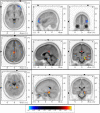The differences in brain activity between narrow band noise and pure tone tinnitus
- PMID: 21048975
- PMCID: PMC2965106
- DOI: 10.1371/journal.pone.0013618
The differences in brain activity between narrow band noise and pure tone tinnitus
Abstract
Background: Tinnitus is an auditory sensation characterized by the perception of sound or noise in the absence of any external sound source. Based on neurobiological research, it is generally accepted that most forms of tinnitus are attributable to maladaptive plasticity due to damage to auditory system. Changes have been observed in auditory structures such as the inferior colliculus, the thalamus and the auditory cortex as well as in non-auditory brain areas. However, the observed changes show great variability, hence lacking a conclusive picture. One of the reasons might be the selection of inhomogeneous groups in data analysis.
Methodology: The aim of the present study was to delineate the differences between the neural networks involved in narrow band noise and pure tone tinnitus conducting LORETA based source analysis of resting state EEG.
Conclusions: Results demonstrated that narrow band noise tinnitus patients differ from pure tone tinnitus patients in the lateral frontopolar (BA 10), PCC and the parahippocampal area for delta, beta and gamma frequency bands, respectively. The parahippocampal-PCC current density differences might be load dependent, as noise-like tinnitus constitutes multiple frequencies in contrast to pure tone tinnitus. The lateral frontopolar differences might be related to pitch specific memory retrieval.
Conflict of interest statement
Figures





Similar articles
-
Choice of test stimulus matters for pitch matching performance: Comparison between pure tone and narrow band noise.Hear Res. 2019 Sep 15;381:107776. doi: 10.1016/j.heares.2019.107776. Epub 2019 Aug 2. Hear Res. 2019. PMID: 31401433
-
Contralateral parahippocampal gamma-band activity determines noise-like tinnitus laterality: a region of interest analysis.Neuroscience. 2011 Dec 29;199:481-90. doi: 10.1016/j.neuroscience.2011.07.067. Epub 2011 Aug 30. Neuroscience. 2011. PMID: 21920411
-
The neural network of phantom sound changes over time: a comparison between recent-onset and chronic tinnitus patients.Eur J Neurosci. 2011 Sep;34(5):718-31. doi: 10.1111/j.1460-9568.2011.07793.x. Epub 2011 Aug 16. Eur J Neurosci. 2011. PMID: 21848924
-
Auditory cortex stimulation for tinnitus.Acta Neurochir Suppl. 2007;97(Pt 2):451-62. doi: 10.1007/978-3-211-33081-4_52. Acta Neurochir Suppl. 2007. PMID: 17691335 Review.
-
Auditory sensori-neural alterations induced by salicylate.Prog Neurobiol. 2000 Dec;62(6):583-631. doi: 10.1016/s0301-0082(00)00027-7. Prog Neurobiol. 2000. PMID: 10880852 Review.
Cited by
-
Thalamocortical Dysrhythmia: A Theoretical Update in Tinnitus.Front Neurol. 2015 Jun 9;6:124. doi: 10.3389/fneur.2015.00124. eCollection 2015. Front Neurol. 2015. PMID: 26106362 Free PMC article. Review.
-
Differences in Clinical Characteristics and Brain Activity between Patients with Low- and High-Frequency Tinnitus.Neural Plast. 2020 Jul 26;2020:5285362. doi: 10.1155/2020/5285362. eCollection 2020. Neural Plast. 2020. PMID: 32774356 Free PMC article.
-
Auditory Neural Plasticity in Tinnitus Mechanisms and Management.Neural Plast. 2020 Jul 1;2020:7438461. doi: 10.1155/2020/7438461. eCollection 2020. Neural Plast. 2020. PMID: 32684922 Free PMC article. Review.
-
Tinnitus: a large VBM-EEG correlational study.PLoS One. 2015 Mar 17;10(3):e0115122. doi: 10.1371/journal.pone.0115122. eCollection 2015. PLoS One. 2015. PMID: 25781934 Free PMC article.
-
The auditory and non-auditory brain areas involved in tinnitus. An emergent property of multiple parallel overlapping subnetworks.Front Syst Neurosci. 2012 May 8;6:31. doi: 10.3389/fnsys.2012.00031. eCollection 2012. Front Syst Neurosci. 2012. PMID: 22586375 Free PMC article.
References
-
- Jastreboff PJ. Phantom auditory perception (tinnitus): mechanisms of generation and perception. Neurosci Res. 1990;8:221–254. - PubMed
-
- Flor H, Elbert T, Knecht S, Wienbruch C, Pantev C, et al. Phantom-limb pain as a perceptual correlate of cortical reorganization following arm amputation. Nature. 1995;375:482–484. - PubMed
-
- Lockwood AH, Salvi RJ, Burkard RF, Galantowicz PJ, Coad ML, et al. Neuroanatomy of tinnitus. Scand Audiol. 1999;51(Suppl):47–52. - PubMed
-
- Axelsson A, Ringdahl A. Tinnitus–a study of its prevalence and characteristics. Br J Audiol. 1989;23:53–62. - PubMed
-
- Heller AJ. Classification and epidemiology of tinnitus. Otolaryngol Clin North Am. 2003;36:239–248. - PubMed
Publication types
MeSH terms
LinkOut - more resources
Full Text Sources
Other Literature Sources
Medical

